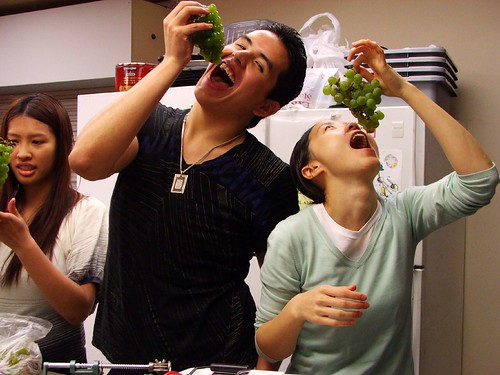
Canning workshop with delicious home-grown grapes.
Canning!
Home canning is both an art and a science. There is lots of potential for innovative flavour combinations and your own personal touch--but there's also potential for food spoilage and contamination.
Don't be intimidated by the risks--preventative measures are built on simple common sense. Specific new knowledge (such as recommended processing times for jars and types of food) is easily accessible in library books or on internet sites.
Beware! Anyone with any level of expertise can claim to be an internet expert. If in doubt, check out your good old local library for materials guaranteed to be rigorously reviewed. Be aware that our knowledge of food safe practices has improved dramatically in the last 25 years or so. Some traditional family recipes (including methods and processing times) are now known to be unsafe.
To be on the safe side, canning recipes from before 1990 should not be used, especially if they do not include instructions for processing. For example, some recipes call for the "open kettle method." In this method, food is prepared, placed in a jar, and stored. The jars aren't heat-processed at all. This method presents a serious food safety hazard.
At the library, choose materials published in the mid 1990s or later. One excellent (though not very colourful) resource is the 1994 USDA Complete Guide to Home Canning. This version contains important updates from earlier editions.
Until about 50 years ago, home canning techniques were common household skills. Today we are witnessing the rising popularity of local food, and a growing awareness that the preservatives in commercially-processed food are harmful to our health. A renewed interest in home canning is part of this movement.

Following up on an earlier post on home canning in a historical context (click the image above to flip back), here are some highlights of our canning season, and some words about safe canning practices.

Barry and Jessica filling jars with grape jelly.
Jars: Regular and wide-mouth Mason-type, threaded, home-canning jars with self-sealing lids are the best choice. These jars and lids are inexpensive and can be found at most hardware and grocery stores. With careful use and handling, the jars may be reused many times. They only require new lids each time.
When jars and lids are used properly, jar seals and vacuums are excellent and jar breakage is rare. Some jar brands you might find at the store include Bernardin, Kerr, and Ball.
Any jar labeled "Mason" will be compatible with the Mason standard metal screw band and lids. These include certain jam and pasta sauce jars. We have had good experiences using Classico pasta jars, but be aware that the Classico company does not recommend using the jars for home canning.
Make sure to inspect jars carefully before use, as seemingly insignificant scratches or chips weaken the integrity of the glass. This can make jars more prone to breaking during heat processing, which can be messy and dangerous.
Prior to use, jars should be washed in hot soapy water and rinsed. Boil for 10 minutes to kill bacteria, and leave jars in the hot water until you fill them up. This prevents cracking that is sometimes caused from pouring hot food into cold jars.
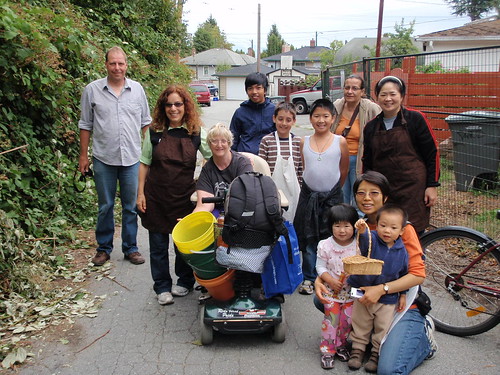
Program participants setting out to pick wild blackberries in Renfrew Ravine.
Rings and lids: It is best to use reusable metal screw bands with one time use lids (pictured here). Don't reuse old lids as they will not form a proper seal and the risk of contamination is high.
When canning, wash lids in hot soapy water, and rinse well. Place lids in HOT, not boiling water, for 5 minutes before using. This helps to melt the wax inside the lids and will form a better seal when heat processing. When sealing jars, try not to touch the underside of the lid to reduce potential bacteria transfer. The rings can be reused and are really only to hold the lids down during heat processing.
Most two-piece lids will seal with a "pop" sound while they’re cooling, as the lid gets sucked down by the vacuum created by the contents cooling and contracting inside the jar. After cooling jars for 12 to 24 hours, remove the screw bands and test seals.
You can press the middle of the lid with a finger or thumb. If the lid springs up when you release your finger, the lid is unsealed. Or try tapping the lid with the bottom of a teaspoon. A clear ringing sound means a good seal. If it makes a dull sound, the lid is not sealed.
Some traditional methods call for sealing jars using paraffin wax. Although paraffin sealing wax is available in the canning section of the grocery store, this method is no longer recommended.
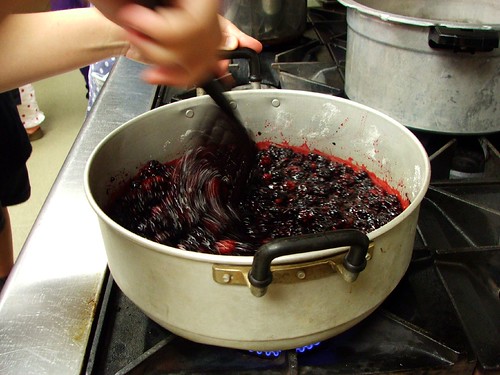
Blackberries reducing. If possible, use stainless steel or glass pots for this process. An aluminum pot like this one may affect flavour.
Pectin: Pectin is a natural product made from fruit. If you feel ambitious, you can even make your own from lemon seeds, apple peels, and cracked plum pits (don't try this with peach pits or apple seeds! They contain harmful substances). Pectin helps your jam or jelly to set. You can make preserves without pectin, but need to add LOTS more sugar and/or cook fruit for longer and/or freeze your preserves. I personally don't think it's worth the trouble, from a nutritional or storage perspective.
There are a lot of amazing-sounding recipes available in books and on the internet. Remember that each pectin brand and product is slightly different and will call for specific quantities of fruit, and a specific order of operations. Most pectin packages come with free recipes inside the box--use these recipes as your basic guide, and modify according to your other recipe ideas. Otherwise you might be disappointed by preserves that are too watery or too stiff.
On a related note, even in the midst of a bumper crop, it's inadvisable to double or triple a recipe. If you've got a glut of fruit, it's better to do two smaller batches than one giant batch, even if you plan to double every ingredient precisely. Bigger batches require longer cooking times, which can result in runny or watery preserves.
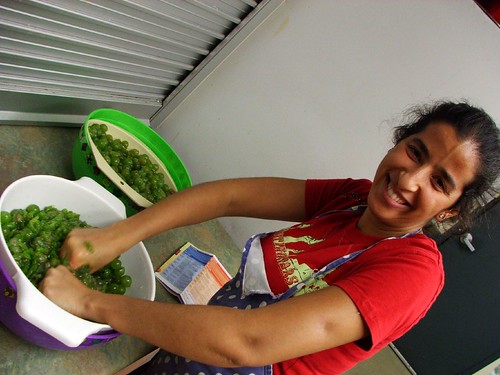
Najia crushes a bowl of donated home-grown grapes to make jelly. As a group of local seniors advised us, a good jelly can't be hurried. If you're going to make preserves, make sure you have lots of time. We all tend to take shortcuts when we're in a hurry, and these shortcuts can result in less-than-desirable products.
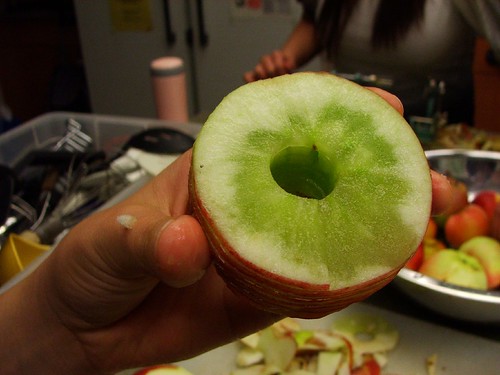
Is this a frostbitten apple? We have no idea.
Fruit! What kind of fruits can be canned? The answer is...almost any kind of fruit or vegetable can be safely canned--but not all can be safely canned at home.
To avoid disappointing results, avoid under- and overripe fruit. Recipes are designed for perfectly ripe fruit and you might end up with overly stiff or overly watery results. I once combined 50% under ripe and 50% overripe plums and got pretty good results, but hey, maybe I was lucky.
As a general rule, fruits (such as strawberries, plums, and blackberries) have a high acid content and should be cooked, jarred, sealed, and processed in a boiling water bath. Vegetables (such as corn and beans) are low in acid content and therefore have a greater tendency to spoil. They should be processed in a pressure canner, where the higher heat and pressure will kill bacteria more easily. Pressure canning is a whole other topic with specific sets of safety recommendations.
Some fruits have a low acid content--notably figs and Asian pears. You can still make preserves with low acid fruits but you'll want to add lemon juice, heat process as usual, and store the jars in the fridge.
*Note: Pumpkin and squash should not be canned at home. It's not a good idea! Even a pressure cooker won't necessarily kill all the bacteria. The risk of contamination is too high. On the bright side, you can definitely freeze pumpkin pulp for winter pies and pudding galore.
Unsure of the acid content in your fruit of choice? It's best to consult a reliable guide before proceeding.
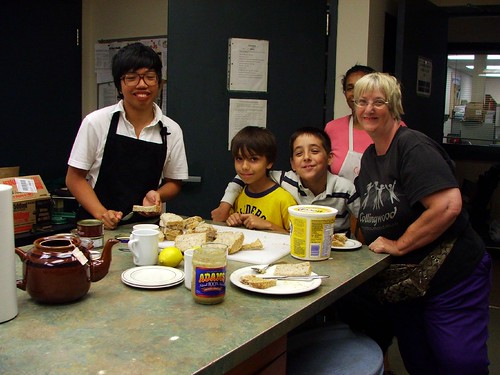
The tasting committee: at the end of the workshop, participants snacked on fresh blackberry and fig jam with peanut butter and whole wheat toast.
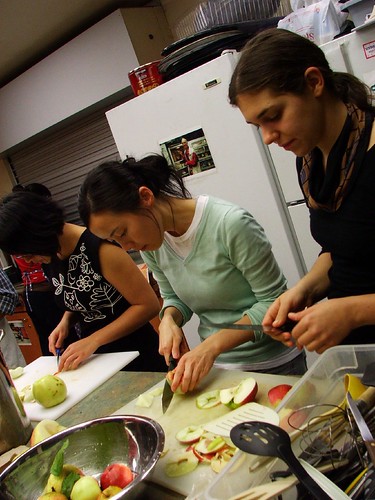
You can improve efficiency and safety of home canning by setting up clean and organized work stations. This is especially helpful when you've got a large group participating.
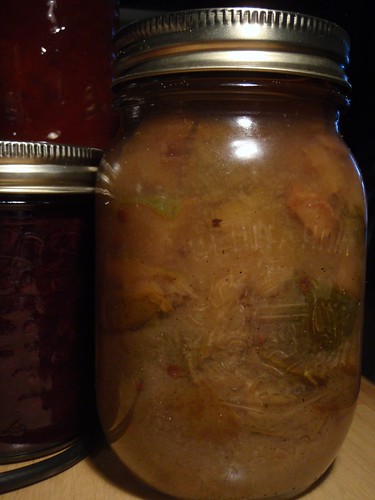
Unlabeled jar of food poisoning mystery. I found this at the back of my cupboard and it's apparent from the cloudiness and discolouration that it isn't safe to eat. Interestingly, it smelled (suprisingly) fine once opened, which just goes to show you appearances can be deceiving. Make sure to label your preserves jars with dates and contents to avoid lethal mysteries like this one.

"Don't touch the inside of the lid!"

Barry, master of the paring knife.

Dave, slicing apples. Disposable gloves are part of good food safe practices, however, many people feel a sense of false security while wearing gloves. They are only effective against contamination if changed regularly, which many people forget to do. Frequent, proper hand washing throughout food preparation is more effective than improper use of disposable gloves.
The fruit used in our canning workshops is locally-grown and often organic. It is donated by local residents through the Grow-a-Row Share-a-Row program, or donated via the Vancouver Fruit Tree Project. Blackberries are picked by volunteers in one or more excursions to the beautiful Renfrew Ravine.
This coming week, Vancouver Fruit Tree Project will be hosting a celebration of their amazing work. Please see the invitation here.
Other canning resources.
Fresh Choice Kitchens is the Community Kitchen program of the Greater Vancouver Food Bank Society. Earlier this year, they hosted an inspiring group of local leaders in a "train-the-trainer" workshop on safe canning practices. Tara Moreau of SPEC (Society Promoting Environmental Conservation) reflected on this experience on the SPEC blog. You can read her thoughts here.
The USDA Complete Guide to Home Canning: here.
The National Centre for Food Preservation: here.
Pick Your Own.Org (slightly disorganized but full of recipes and helpful advice): here.
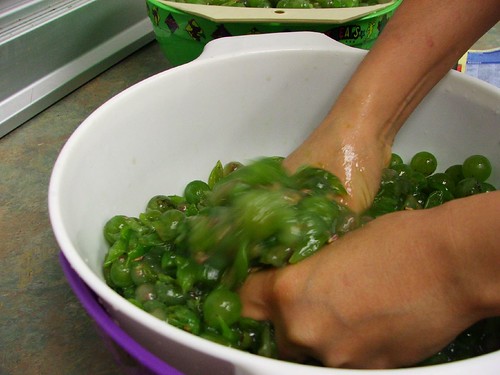

1 comment:
Thank you for this post. Canning of food has been used by many generations before us, and is still used today. Preserving the fresh produce is one of the major reasons why canning is still popular. We’re talking about preserving the nutritional value. See more http://survival-mastery.com/diy/food_preserv/complete-guide-to-home-canning.html
Post a Comment